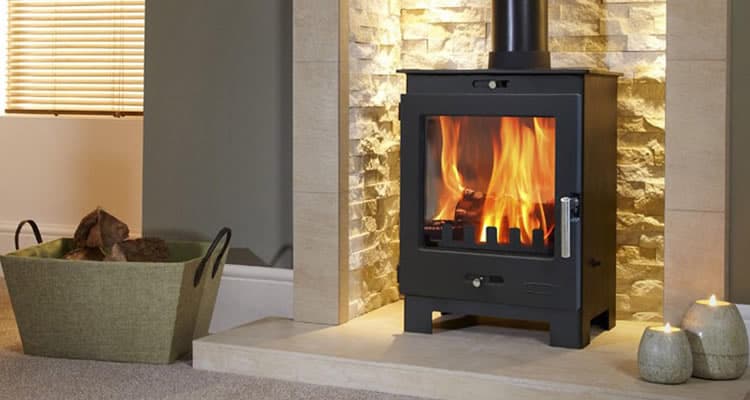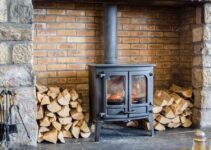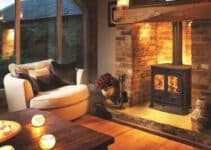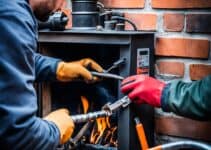It’s hard to beat the authentic crackle and warming glow of a traditional log burner, but many homeowners worry that their property might not be suitable for this time-honoured mode of heating.
One question people frequently ask is can I have a log burner without a chimney? The good news for those without a chimney is that you don’t need one to have a log burner or wood stove safely installed. You will, however, need a way for the fumes and smoke to escape. This is usually done via what’s called a twin wall flue system.
Depending on your property and your preference this can be done in a variety of ways. It is likely to require a certain amount of professional work, or extremely skilled DIY.
Let’s take a closer look at what this all means, how you can have a log burner installed without a chimney, and what factors to consider when weighing up the work required and the associated costs.
How Much to Install a Log Burner Without a Chimney?
It’s likely to come as no surprise that, without a chimney vent, your wood burning stove is going to need an alternative way of getting rid of smoke safely and swiftly.
This is where a twin wall flue system comes in. You might also hear such systems referred to as prefabricated chimney systems.
A twin wall flue is usually a series of circular, stainless steel pipes that connect together, attached to the log burner itself via a stove pipe, before running to a safe outdoor space where the smoke can escape.
In order for the smoke and fumes to rise swiftly and safely, flue systems have to be properly positioned, properly angled, and properly insulated.
The latter is why they are often called ‘twin wall’ flue systems, as they typically consist of an inner steel pipe, surrounded by a thick layer of insulation, and finished with a second, protective outer layer.

In addition to the materials needed for the flue itself, you will also need to manufacture a path for the flue to take. This may require holes to be made in existing brickwork, ceilings, roofs, or external walls.
The size and set-up of your property is therefore a huge factor in determining the overall cost of having a twin wall flue system properly fitted.
You might also hear people talk about internal or external flue systems. Internal systems involve the flue pipe running up through the inside of your home, through the ceilings, and out via the roof.
External systems usually have the flue pipes running from the stove and out a nearby external wall, before then rising up the side of the building to deposit smoke safely above the property.
Generally speaking, internal flue systems may require more labour and preparation, and therefore more cost, than external ones.
This is because they usually involve a greater number of floors, walls, and ceilings being drilled or cut through to make way for the piping.
That being said, many people prefer to keep their stainless steel chimney flu inside, rather than have it crawling up the side of their external brickwork.
How Much Does it Cost to Install a Log Burner Without a Chimney UK?
When you factor in materials and labour costs, not to mention the cost of the log burner itself, you are likely to be looking at thousands rather than hundreds of pounds.
The exact cost of the installation can of course vary wildly depending on the type of stove you choose, the location of the stove in relation to where the flue needs to reach, and the amount of materials or work required to make sure the piping is safely guided through your property.
Some people are tempted, especially when considering the costs of labour, to take on the installation of their flue system as a DIY job.
Whilst not an impossible task for a skilled, experienced, and technically-able DIY-er, there are a range of factors that mean paying for a professional, HETAS accredited engineer to fit the system is often a safer, worthwhile investment.
Log burners can emit noxious and potentially fatal carbon monoxide fumes, so there are a range of building regulations specifying how they and their accompanying chimney systems need to be installed.
In the case of a twin wall flue system, some of the regulations include not exceeding more than 4 bends in the flue pipe, with each of these bends being no more than 45 degrees.
There are also regulations governing the distance that a non-insulated stove pipe can sit from combustible materials and guidance around the proper heights needed for a flue system to be effective.
Any DIY work you carry out installing your twin wall flue system will need to be signed off by a regulator anyway, which could result in costly refits and the subsequent hiring of professionals.
Given that the risks of fitting the piping yourself can be, at best, expensive and, at worst, fatal, it really is worth getting your log burner system installed by an experienced, accredited engineer.
Log Burner Without Chimney Costs
There is no fixed price for how much installing a log burner without a chimney could cost, but when assessing quotes or trying to price up the operation yourself, here are some factors to consider.
Twin wall flue piping itself can cost anywhere from £60 to £100 a metre. You’re also going to need fixtures, supports, connecting materials, cowls, and other accessories that could add to this.
The cost of labour could run to several hundreds of pounds a day for an experienced engineer, with price increasing for every extra pair of hands required to get the job done.
Some firms may be able to handle smaller, external flue system fittings in a single afternoon or day. Other jobs could take the best part of a week if numerous walls, ceilings, or floors need to be worked on.
Your stove and stove pipe itself could cost anywhere from £400 for a second-hand piece, all the way up to £6000 and beyond for new, high-quality models.
Many log burner installations will also require tiling, insulation, and other internal work to prepare the area for the stove and ensure it’s safe.
Again, many of the safety aspects of this installation will need signing off by a regulator, so confident DIY-ers will need to make sure that they’re working within strict specifications for the stove to be green-lit after it’s been installed.
How Much to Install a Log burner With a Chimney?
It can be the case that having a pre-existing chimney makes the installation of a log burner marginally cheaper.
For starters, if a working chimney vent can be used as a path for your stove’s flue, it can obviate the need to knock new exit holes in walls, ceilings and roofs.
That being said, just because your house comes with a chimney stack doesn’t mean that installation is as simple as placing your log burner underneath the hole and running a stove pipe into the shaft.
Chimneys still need to be properly lined and sealed in order for them to be safe, whether this is via a double wall flue pipe or another form of chimney lining system.
Unlined brick chimneys can not be used to vent smoke or by-products of combustion.
In these instances, it is worth having an experienced engineer or stove-fitter assess your particular chimney space, to determine whether the chimney is already suitably lined or whether it can safely be used to route a new flue pipe from the stove to the roof.
Chimneys also require a number of other accessories for their extraction to function safely.
Chimney caps, sometimes referred to as cowls, are just one example – they’re a cover that helps keep debris or animals from flying down the chimney, as well as keeping flaming embers from drifting out and damaging your roof.
Such accessories may need to be fitted, raising the price accordingly.
Labour costs to carry out the necessary surveyance and work could still cost several hundreds of pounds a day, though you may find that less time has to be spent drilling fresh exit holes.
Material costs for twin wall flue piping are likely to be similar, with current rates averaging between £60 and £100 per metre.
Can I Have a Wood Burner If I Don’t Have a Chimney?
In conclusion, yes! It’s possible to have a wood burner or log stove without having a chimney in your home, though you will need to install some form of smoke extraction system for your stove to function safely.
Most wood burners without chimneys will use a twin-wall flue system to remove smoke and harmful by-products from the combustion chamber.
The installation of these systems can be complex and are governed by strict safety regulations.
Though the cost of labour can lead some keen DIY-ers to attempt the installation themselves, we would always recommend having a HETAS accredited engineer fit your stove, along with any requisite chimney and flue systems.



